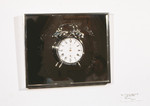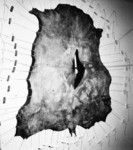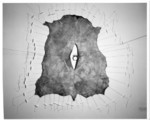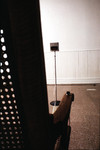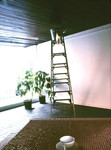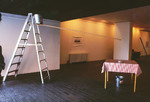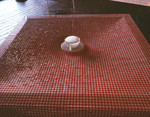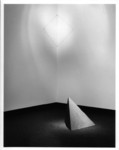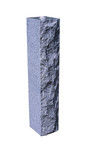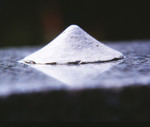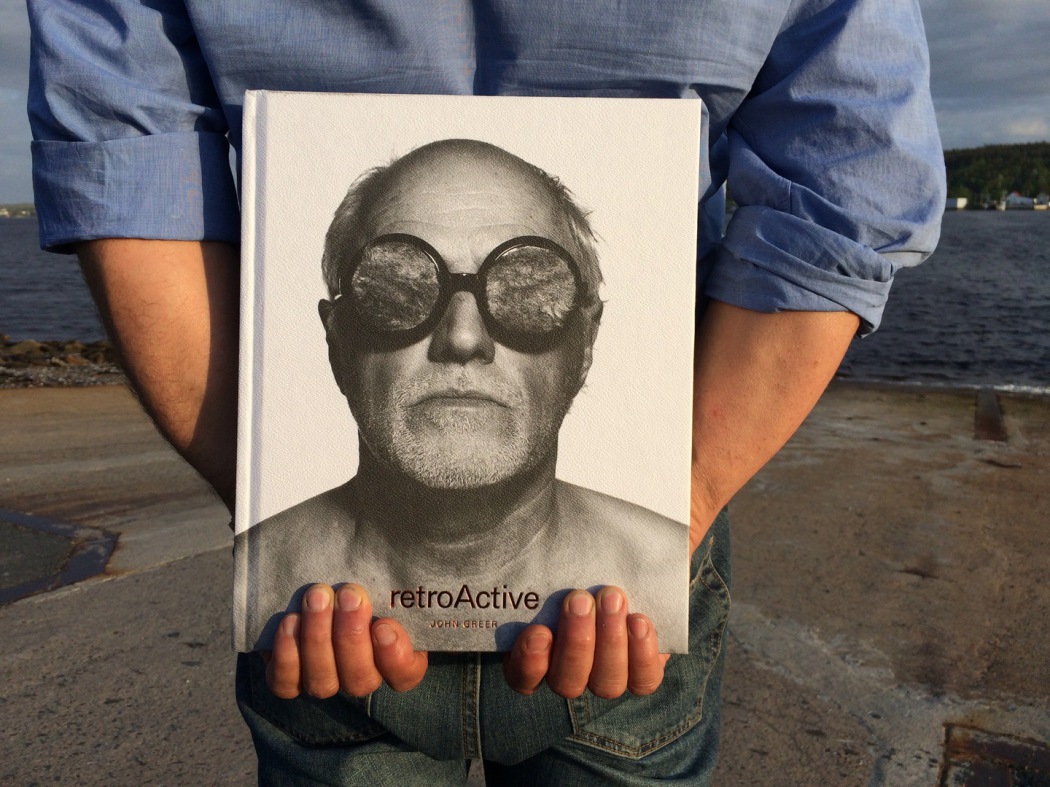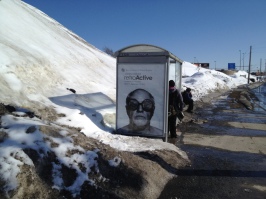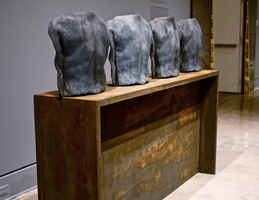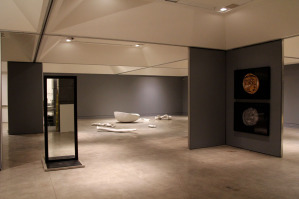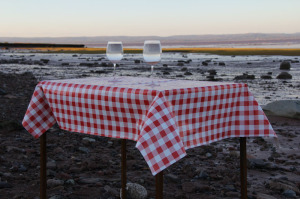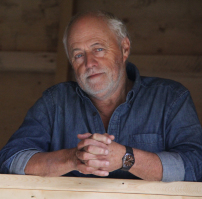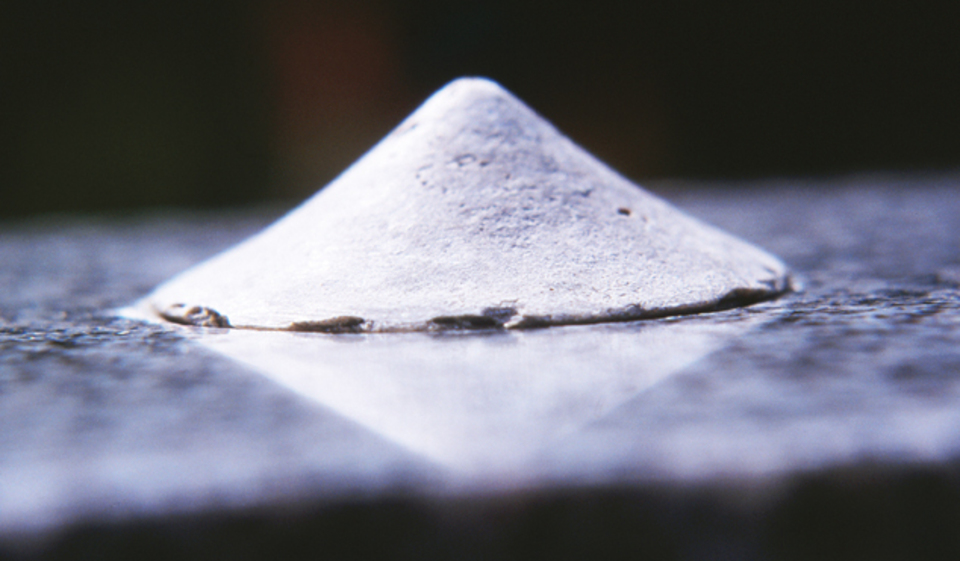
On and of the world
Me, the world, the objects and the life - we are situations of energy,
and it is important that these situations do not crystallize,
but stay open and vital, and are part of our life.
Giovanni Anselmo 1969
John Greer was born in the Maritimes and with the interruption of a few years living in Vancouver, Montreal and Toronto, spent most of his life close to the Atlantic Ocean. In fact it is the ocean that is one of the most influential sources of inspiration for him, inspiring him for his undertakings into the realm of space and time, governed by natural forces.
"Looking out to sea" 1974, a photo-word statement at the beginning of a catalogue, is a statement on his way of looking at things, - seeing as an act that is far from being a mere intellectual reception of some distant object. Looking at things involves for Greer always the act of experience. This act of experience is charged with our sensual capabilities of feeling - seeing; hearing reinforced through visual information; touching with a quality that goes beyond the surface. "Move your eyes to the right" 1972, (type on paper) is a directive for an exercise that improves one's abilities to look right. The work consists of a paper-band that is fixed to the walls of a gallery room, encircling the space in a height that makes the viewer lift his head, opening his vision while reading the instruction: Move your eyes to the right - reflect on your feet - move your eyes to the right - reflect on your ankles - move your eyes to the right - reflect on your knees - move your eyes to the right - reflect on your hip ... going on asking for reflection on waist, chest, shoulders, neck, eyes. Here, language is used as a tool, again, in order to get the viewer intellectually engaged and through that - actively move - perceiving - around the whole room.
" 'Sense' covers a wide range of contents: the sensory, the sensational, the sensitive, the sensible, and the sentimental, along with the sensuous. It includes almost everything from bare physical and emotional shock to sense itself - that is, the meaning of things present in immediate experience." (John Dewey)35
According to Greer, we perceive and experience the world around us through the collective of our senses. We are part of it as we perceive the quality of a living experience - with its richness and wonder. He is reminding us of the importance, that all this is directed by our conscious movement and "human will" - and can not be separated, - since any experience can only be carried to an understanding through the combination of human mind and physical participation. Only then a meaningful encounter can take place and evaluate an intercourse into life itself. The act of seeing is therefore an activity, which enables us to a conscious encounter.
In 1972 Greer investigated the act of seeing with an outdoor piece "Eyes on Sea Level". Based on the word “sea level” he wondered where this really was and - waited with the eyes on the measured sea level for the tide to come in. This showed him the ground level for our confrontation with the world. Connecting the act of seeing to this physical process of gravitational balance - a physical information that is inherent in any object, in any living creature - means relocating the moment of experience, the moment of physical and visual encounter into a state of balance between body and mind. It is a felt understanding of seeing. In 1991 Greer wrote connected to the work "Reconciliation", in regard to this early piece: "The notion of the viewer in the context of art should be questioned in regard to sculpture.(...)To view sculpture, you must maintain the body in space awareness and encounter the object or sculpture as an equal. The authority of your body should not be relinquished, as it is when you look into the second dimension. Your sensibilities must remain physically grounded." (John Greer)36 This process of grounding oneself, the individual in the awareness of the incredible forces of nature, made him execute a few spectacularly modest works out in the Bay of Fundy already 20 years before that statement. One of them is "Tide up - Tied down" 1971 (two photographs, 16" x 16" each, with text) documented the work, consisting of a kitchen table which was decorated with checkered table cloth and two wine glasses fixed on top of it. The table, too, was fixed to the ground, so that it would restrain the incoming tide. Greer wrote:
Tide Up Tide Down
3,360,000,000 Tons of Water
6 Hours 12 Minutes incoming
Depositing 8 Ounces (2 Glasses)
This is a way of breaking down a natural phenomenon on a human scale: thousands of tons of water come in, in order to leave us two glasses full. With this simple device, Greer tried to make sense of the flow of energy and time of nature as it relates to our daily life. Another way of getting a grip on an extract of space and element in front of uncountable masses is the "Bass River Piece" 1971 "Water Bottle. A group of photographs (not a series) are showing various positions of the piece. I took a 5-gallon bottle and fixed it to a piece of plywood. To each corner of the plywood, I attached 10-foot ropes. The tide lifted the sheet of plywood to the ten-foot level and continued to rise, filled the bottle and rose another ten feet. The tide ebbed and I capped the bottle full of water. This contained water rose with the following tides, occupying the original space from which it was obtained.
Unexpected occurrence: On the second night and the fourth tide, being a night tide, a storm blew up. One of the ropes broke. The plywood pounded on its side in the surf. The bottle came loose and broke. The contained water was returned to the sea. August 11, 1971." (John Greer)37
The importance of these pieces does not lie in the human intervention as an act of art, but in the experience and location of a part, a particle of an entity, always including space and time as basic elements for consideration.
Time is here taken as a spatial dimension - in opposition to the general understanding of time by our society, which is deforming it as an applied mental construct for definition.
An early work of Greer, "Past Tense" 1968 is concerned with time as a succession of temporary events. It consists simply of newspaper sheet that is tightened at the wall. The meaning of temporality is expressed through the image of actuality as timely concern.
"Space (..) becomes a comprehensive and enclosed scene within which are ordered the multiplicity of doings and under goings in which man engages. Time (...) is the organized and organizing medium of the rhythmic ebb and flow of expectant impulse, forward and retracted movement, resistance and suspense, with fulfillment and consummation. (...) Time as organization in change is growth, and growth signifies that a varied series of change enters upon intervals of pause and rest; of completions that become the initial points of new processes of development. (John Dewey)38
Greer worked on the same problematic for years, starting in his childhood: The concept of time that he had to learn never made any sense to him. Whenever he looked at the watch, it was in the awareness of it being now. For him, the numbers and hands were a construct signifying something else. For him, time was passing through the change of form and appearance. As a kid he started to play with alarm-clocks, taking the hands off: "I took the hour-hand off; no problem, because you go somewhere else in the world and it is a different hour at the same time. I did the same with the half-hour hand; I took it off. I could take the alarm hand off, as well, because the alarm always rings. I just could not take the second hand off. There is no way to take the second hand off, because it is always the same second." (John Greer)39 He used his own construct to get this in an order, past, present future being 1,2,3:"The present is the number 2, the second number, so we are having a second chance every second of the day. I think time is a reflection. Not real. The reality is this." (John Greer)40
"It is all hours of day and night" 1975, is an alarm clock incorporated in the middle of a mirror plane, without hour- and alarm-hands, but only the second-hand running. The alarm here is not as alarming as it looks. It is reflecting on us and the world; always including the presence as chance and risk. Seeing the now and then in this small object all at once, reduces the alarm to a casual and conscious encounter.
"The Time of your Life" 1976 combines this take on time with the artist's individual take on the act of art as a meaningful experience for the flow of life.
It is interesting and helpful for an understanding to look at Greer's early work in comparison to the European movement of the Arte Povera. The use of material, the denial of (personal) history and the way of taking art into the realm of the real by giving statements instead of images as ideas is very much the same in the approach to the work. "The Arte Povera is far from an object-like or iconographic apology, it is independent, almost intuitive, and puts mimesis in its place of triviality and functionality, while the idea and the general law are brought to the fore. (...) One could almost talk about the rediscovery of an esthetic tautology: e.g. the sea is water, a room is an amount of air, cotton is cotton, the world is an almost imperceptible entity of nations, a corner is a meeting point of three coordinates, the floor is an accumulation of tiles, life is a sequence of actions. The visualized ideas, events, facts and actions direct the eye towards the simultaneity of idea and image, they lead merely to an enlargement in the surrounding of that idea, events, facts and actions, they do not sidetrack through indistinct or ambiguous elements. They make natural and human facts and laws visible."(Germano Gelant)41
In "The Time of your Life" you do have animal skin breathing with your steps on a designated wooden floor area, revealing an alarm clock that, again, is objectifying NOW for the flow of time. The material is chosen to talk through its specific qualities, encountered through the experience in the act of art.
"Come pass some Time" 1979 is even more direct in its take on the experience of time through the reflection on the individual history of the viewer. You are invited to sit on a chair which seems to be a combination of all traumatic and heroic chair experiences known to you - from dentist to hairdresser, from throne to wheelchair, armchair or control tower, waiting room or electric chair - and with a button on the armrest you are able to set the time, move the numbers of a digital clock. It puts the viewer in a most powerful position, enabling him to bring time ahead of the mind and in turn project the intellect into the space of timelessness.
A different quality of space and time is condensed in works like "Salt Water Fountain" 1972, "Tap Dance" 1976, or "Storm in a Teacup" 1977 - where the emphasize lies on the material and its spatial deforming, salt water versus rain water - dropping and slowly dissolving as it is describing the radius of flow with its materiality - or the object-subject idea, the leaking bucket, collecting sound and movement through release of the contained water, the teacup - being the container of a miniature storm, collecting forces that are not even set free. Time is here an inherent element that is giving relevance to the art experience as a moment of subtlety.
Next to these early investigations into time, Greer developed a sense for what space is as element that is in correspondence to a person's body and mind. Sculpture is a key for him to get the senses back to the experience within the world. In the catalogue for "The Embodied Viewer" he wrote "(...)Sculpture is located in the unambiguous space of the world in which we live. We view sculpture with the same physically informed body with which we negotiate through the tactile world of everyday. The intellect is grounded in this routine physical experience. It is the language of understanding objects. This everybody, everyday language must be coupled with the developed visual language of art in order for sculpture to be meaningful experienced. The viewer of sculpture should not take a sculptural image into the brain for consideration as he does when viewing two-dimensional space. This would make the body redundant psychologically!" (John Greer)42
As mentioned earlier, he considers "Stone" 1978 to be his first sculpture - it works directly with the substantiality of its material in opposition to the viewers mental approach to the illusionary reflection - connected in turn to his relation as a "relating object". This work is close to two other works that are tempting similar qualities of space and illusion: "Juggling" 1970-1980 is a construction between space and non-space. For Greer the latter is the construct of the human mind. Form is juxtaposed with a sign for the idea of form, using the architectural space as support. Moreover he sees the space within in reminiscence to the negative space between two cupped hands. Sculpture is here an encounter of exercise, training sense and sensibility for space and suggested space mirroring each other.
"Ever since, the spatial problems belong to the field of architects, but the space of architecture is defined by plains, that is to say, something three-dimensional is indicated by something two-dimensional. In my case, as sculptor, the two-dimensional is also defined by something three-dimensional, and those two groups of space, which you could name the negative-empty and the positive-full, stand in close proximity, I would even talk about a dialogue." (Eduardo Chillida)43
In "Juggling", Greer is visualizing this dialogue through defining space with two-dimensional means, in contrast to its definition through mass and substance. In addition he is researching a third category, the illusion of space through reflection - or through the balance of energy as force. All three definitions go hand in hand for Greer and he made a few pieces that document this understanding of space. Therefore they are a link to newer works of the artist.
"Alterior motive" 1977 is a work, where the artist is using stone as the medium for a base - the centre of interest is in the middle of the polished top-plane. Two cones are formed out of bone meal and fixed base to base. The form is set into the stone so that the top half is visible - the bottom cannot be seen, but imagined through the reflection of the upper half on the blank surface. Thus form and reflection coincide, take the same space. This piece combines all three categories of space - putting together form, plane and illusion in order to state a little theorem on space. The size is related to our body, putting the cone in reach of our hand, displaying it. The base in stone adds to the meaning as a reminder of the plumb, sustaining the weightlessness of the bone meal shape.
Greer used bone meal together with granite in another piece, "Passing Through" 1980. A rough-cut block of granite is cut in two halves, the cut becoming the polished top surface of either side. A hole is carved into the middle of both in the shape of a cone. One of the pieces contains an object made out of bone meal, which in turn is in the shape of two cones, base to base. Each of them fits exactly into one of the negative shapes of the stone. You could put the granite block back together and it would contain the bone meal shape as center - invisible to the eyes of the viewer. Greer unfolds this stone for us like a book; the two pages are marked so that one knows about their original position. This work shows in a very simple way the balance of form (matter) in space, material being in the world - changed only through repositioning, but not through elimination as it is possible by looking at images.
The rough split stones, lying on the floor, are not working like a base, but are already insinuating Greer's use of sculptural objects as elements in the relativity of space - which is including the viewer as equal part.
"On the level" 1981 is using material language on different levels. It shows its tautological meaning: granite is volcanic magma, non living earth, the material plane we step on; marble is stone made up of previously living material (crustaceous), contains latent energy of consciousness, manifests live in stone. The shapes of the material are using images that make up a social context: the cone is the transitional shape from triangle to circle. A triangle is traditionally used to symbolize the corporal living plane, the transitional plane between earth and heaven; the circle is traditionally the spiritual plane; the square or cube stands for the material plane. The participating viewer opens the third level of understanding himself, through mental projection: the towers refer to human size and are negative or hollow forms that can hold the granite shape (base) and the marble (top, opening in the form of a circle). But only one of them actually holds the double cone made out of marble. The viewer is stepping between the reminders made out of steel, that frame symbolism and material possibilities. Your eyes are on the same level with the circular plane holding the symbol and its potential. The work is speaking for the human perspective and in turn its potential for the challenging balance between matter and mind. "The granite pedestal as material plane awaits the viewer, who will vacillate between a rather eroded cone and one which seems to have disappeared by levitation or gravitation. This sentry-surrogate system has a basis in truth (reality). (Patrick Condon Laurette)44.
Greer's understanding of being in and of the world is deeply rooted in this belief in truth, meaning our natural reality. He investigated the state of being and thinking in connection to our location on the world - and our existence as part of the world, as an object among objects.
35 John Dewey, Art as Experience, Perigee Books, New York, 1988 c.1934 p.22
36 John Greer, The Embodied Viewer, Glenbow Museum Calgary, 1991, p.24
37 John Greer, Sceptical Art Works at the Killam, Dalhousie Art Gallery, 1974
38 John Dewey, Art as Experience, Perigee Books, New York,1980, c.1934 p.23
39 John Greer in an interview with the author, Berlin, march 1997
40 John Greer, ibid.
41 Germano Gelant, Eine Arme Kunst (1968), Arte Povera, Wiese Verlag Basel, 1989 p.26f.
42 John Greer, The embodied Viewer, Glenbow Museum Calgary, 1991, p.24
43 Eduardo Chillida, Carola Giedion-Welcker, Chillida In: Quadrum 20, 1966, p.44, quoted in Eduard Trier, Bildhauertheorien im 20. Jahrhumdert, Gebr. Mann Verlag Berlin, 1992 Neuauflage, p.107
44 Patrick Condon Laurette, Sculptural Objective 1968-1981, Art Gallery of Nova Scotia, 1981





